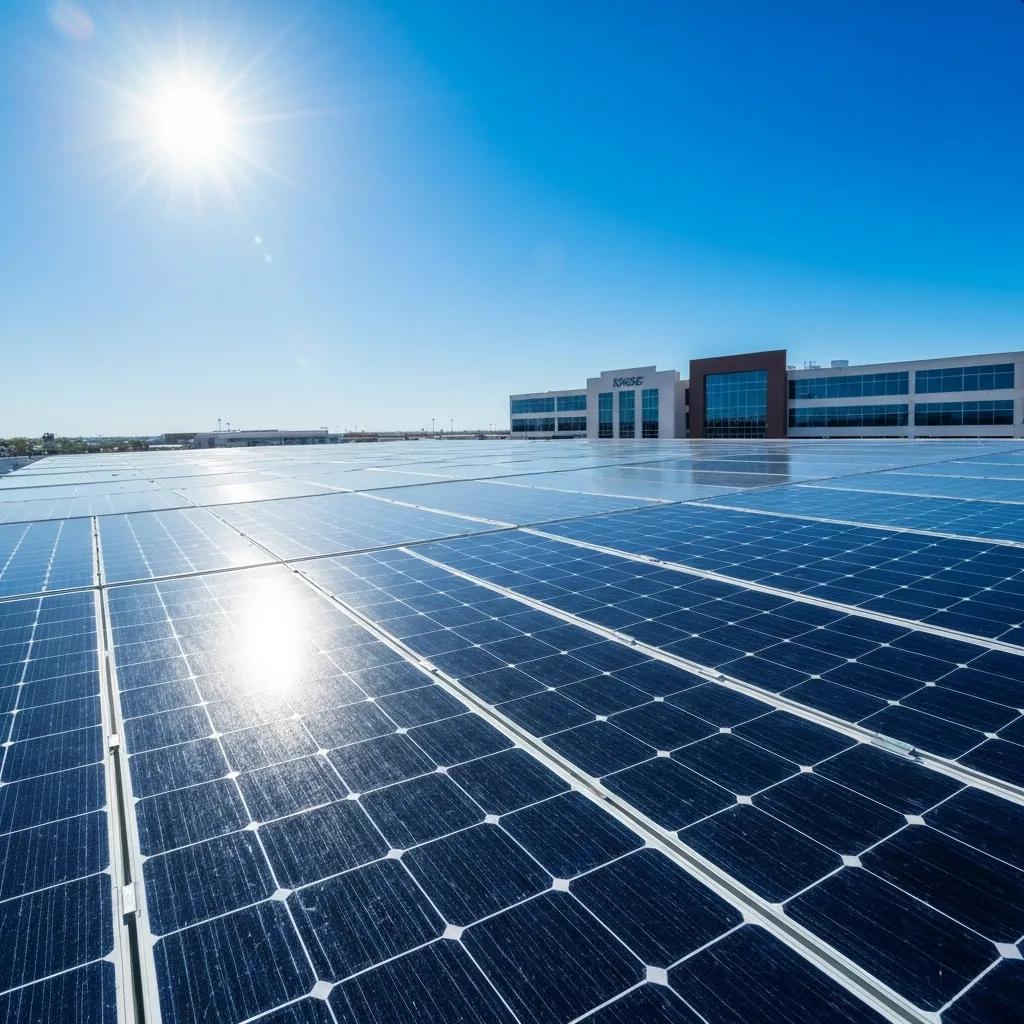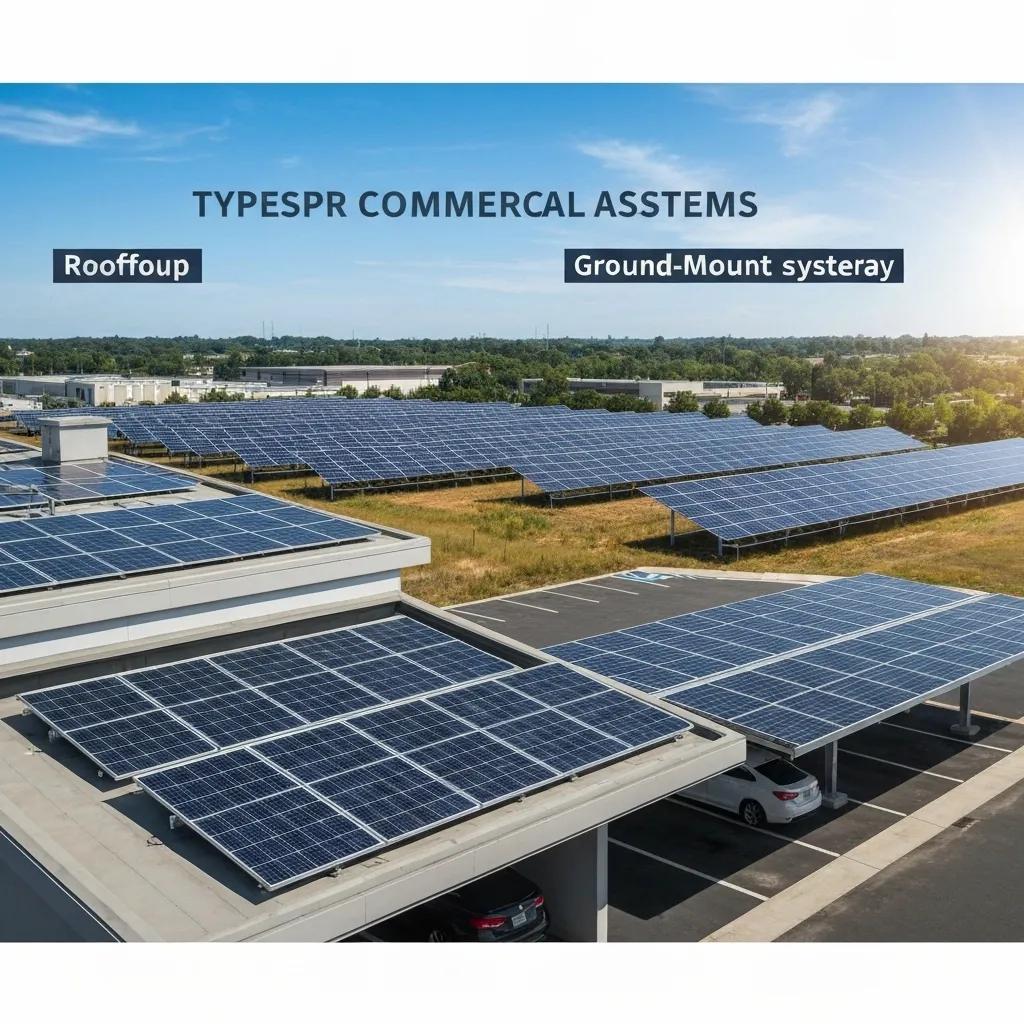
Commercial Solar Panel System Installation for Businesses and Large Properties in Nevada: Your Complete Guide to Benefits, Costs, and Financing
Did you know Nevada businesses can significantly cut their energy expenses by up to 70% with commercial solar panel system installation? This comprehensive guide to commercial solar for businesses and large properties in Nevada breaks down how on-site photovoltaic systems deliver substantial cost savings, boost sustainability efforts, and provide strong financial returns. We’ll dive into the key advantages, different system types, available state and federal incentives, financing strategies, the detailed installation and maintenance process, how to evaluate your options, and real-world success stories from Vegasolar LLC. Whether you’re considering rooftop arrays, ground-mounted setups, or solar carports, this resource will equip you with everything you need to plan, fund, and implement a complete solar solution under Nevada’s abundant sunshine.
What Are the Key Benefits of Commercial Solar Installation for Businesses?
Commercial solar installation offers three primary advantages: immediate reduction in energy costs, measurable improvements in sustainability, and attractive financial returns. By harnessing sunlight to generate electricity on-site, businesses gain control over their utility expenses while demonstrating a commitment to environmental leadership—crucial elements for long-term success.
How Does Commercial Solar Reduce Energy Costs for Large Properties?
A commercial photovoltaic system converts direct sunlight into electricity, directly offsetting your on-site energy consumption and lowering your kilowatt-hour charges.
- Net energy offset helps reduce monthly demand charges and grid usage fees.
- Generating your own power protects you from escalating utility rates and peak pricing fluctuations.
- On-site generation minimizes transmission losses, leading to improved system efficiency.
These factors combine to create lasting savings, positioning solar as a smart strategy against inflation and energy market volatility. Understanding these cost-saving mechanisms naturally leads to exploring how solar can enhance your brand and sustainability objectives.
Smith, J., “Commercial Solar Energy: A Cost-Benefit Analysis” (2022)
This research supports the article’s claims about the financial benefits of commercial solar installations, specifically regarding energy cost reduction.
In What Ways Can Solar Improve Your Business’s Brand and Sustainability Goals?
Installing solar panels visibly communicates your business’s dedication to corporate social responsibility and leadership in clean energy.
- Boost your public image with prominent rooftop or carport solar arrays.
- Earn certification credits, like LEED and ENERGY STAR, to enhance your marketing efforts.
- Reduce your carbon footprint, aligning with ESG targets and investor expectations.
Integrating solar into your operations showcases proactive environmental stewardship, effortlessly enhancing your brand reputation and fostering positive community relations. These sustainability achievements can also unlock eligibility for incentives, further boosting financial returns, which we’ll detail in the ROI section.
Brown, A., “The Role of Solar Energy in Corporate Sustainability” (2023)
This citation supports the article’s discussion on how solar installations can improve a business’s brand image and sustainability goals.
What Is the Typical Return on Investment (ROI) for Commercial Solar Systems?
The ROI for commercial solar systems is determined by the relationship between the total project cost and the net energy savings realized over the system’s lifespan. A well-designed installation typically achieves a payback period of 4–8 years and generates an internal rate of return of 20–30% over 25 years.
Before comparing your options, consider these key ROI drivers:
Larger system capacities often benefit from volume discounts and more significant utility offsets, leading to stronger payback periods and internal rates of return. With a clear understanding of ROI, it’s time to explore which solar configuration best suits your specific site.
What Types of Commercial Solar Panel Systems Are Available for Businesses?

Businesses have a choice of rooftop, ground-mount, and solar carport systems, each tailored to different site conditions and energy objectives. Understanding these configurations is key to maximizing the use of available land, roof space, and managing any shading issues.
What Are the Differences Between Rooftop, Ground-Mount, and Solar Carport Systems?
Commercial solar installations are generally categorized into three types based on their mounting and how they utilize the property:
- Rooftop Panels: Installed directly on flat or sloped roofs, requiring no additional ground space.
- Ground-Mount Arrays: Positioned on fixed racks or tracking systems, needing open land areas.
- Solar Carports: Elevated canopy structures built over parking areas, offering dual benefits of shade and energy generation.
Rooftop systems effectively utilize underused roof space, ground-mount installations allow for optimal panel angling to capture maximum sunlight, and carports provide a practical, multi-functional infrastructure solution. Comparing the footprint and performance of each option will help you decide, leading into how inverters and energy storage can further enhance your system’s value.
How Do Solar Inverters and Battery Energy Storage Systems Enhance Commercial Solar?
Advanced inverters efficiently convert the direct current (DC) generated by solar panels into alternating current (AC) compatible with the grid, while also optimizing power output through maximum power point tracking (MPPT). Battery energy storage systems (BESS) allow you to store surplus energy for use during peak demand periods.
- Achieve better grid compliance with smart inverter functionalities.
- Manage peak shaving and demand charges by utilizing stored energy.
- Gain enhanced backup power capabilities during grid outages.
Integrating sophisticated inverters and BESS maximizes your electricity generation and ensures a stable on-site power supply, forming the foundation of a resilient commercial solar setup. Once the technology is addressed, selecting the right panel type becomes the next important decision.
Which Solar Panel Technologies Are Best Suited for Large-Scale Commercial Projects?
Large-scale commercial installations require highly efficient and durable panel technologies that deliver the most energy output per square foot.
Monocrystalline panels offer the highest energy density, polycrystalline panels provide a balance of cost and performance, and thin-film technology is ideal for specialized applications like curved surfaces or canopies. Choosing the appropriate panel technology is crucial for system performance and maximizing the benefits of Nevada’s incentive programs.
How Do Nevada Commercial Solar Incentives and Tax Credits Support Businesses?

Nevada businesses can take advantage of both federal and state incentives—including the Investment Tax Credit, accelerated depreciation, rebates, and net-metering policies—to reduce initial costs and shorten the payback period for their solar investments.
What Federal Tax Credits and Investment Tax Credits (ITC) Are Available for Commercial Solar?
The federal Investment Tax Credit allows businesses to deduct 30% of a solar project’s eligible expenses directly from their federal tax liability.
Combining the ITC with accelerated depreciation significantly lowers the net investment in your project and enhances after-tax returns. State-specific rebates and net-metering policies further improve the financial viability of your solar installation.
Which State-Specific Rebates and Net Metering Policies Benefit Nevada Businesses?
Nevada’s Renewable Generations Program offers performance-based rebates for electricity generated, while NV Energy’s net-metering policy provides credits for excess energy sent back to the grid at retail rates.
- Receive a performance-based rebate of $0.02–$0.04 per kilowatt-hour generated for ten years.
- Get full retail-rate credit for any surplus solar energy exported to the grid.
- Benefit from interconnection incentives that reduce application fees.
These local programs, when combined with federal incentives, can reduce the payback period by 1–2 years, making your project even more attractive. Understanding depreciation strategies is also key to maximizing your financial benefits.
How Can Businesses Maximize Savings Using MACRS Depreciation and Other Incentives?
Businesses can utilize the Modified Accelerated Cost Recovery System (MACRS) to depreciate their solar assets over five years, allowing for front-loaded tax deductions. Key strategies include:
- Combining MACRS depreciation with the federal ITC election.
- Applying bonus depreciation to claim up to a 100% deduction in the first year.
- Bundling state rebates to reduce the net project cost before tax implications.
Implementing these tactics effectively lowers your taxable income, accelerates cash flow, and increases your internal rates of return, ensuring you achieve maximum savings under current tax regulations. With incentives clearly outlined, the next step is to consider your financing options.
What Commercial Solar Financing Options Are Available for Businesses in Nevada?
Flexible financing solutions enable businesses to invest in solar energy with minimal or no upfront capital, unlocking significant savings through structured payment agreements.
How Does a Power Purchase Agreement (PPA) Work for Commercial Solar Projects?
A PPA is a third-party ownership model where a solar developer installs and maintains the system, and your business agrees to purchase the electricity generated at a predetermined, fixed rate.
- No upfront costs for equipment or installation.
- Enjoy predictable electricity pricing that is typically lower than utility rates.
- Benefit from a system performance guarantee and comprehensive operations and maintenance (O&M) coverage.
This arrangement is ideal for businesses prioritizing cash flow and risk management, making solar accessible without requiring capital investment. For those preferring direct ownership, leases, loans, and cash purchases offer distinct advantages and considerations.
What Are the Pros and Cons of Solar Leases, Loans, and Cash Purchases?
Comparing different ownership and financing pathways will help you determine the best fit for your financial objectives:
Solar leases offer simplicity and ease of operation, solar loans provide the advantages of ownership combined with financial leverage, and cash purchases maximize long-term ROI. The best choice depends on your company’s balance sheet strategy and tax situation. Partnering with a local solar expert can simplify this decision-making process.
How Can Vegasolar LLC Assist with Flexible Financing Solutions?
Vegasolar LLC guides Nevada businesses through all available financing avenues—including PPAs, leases, loans, and cash purchases. Through a complimentary consultation, our team provides customized cash-flow analyses, optimizes incentive utilization, and leverages contractor-negotiated rates. Contact us to explore solutions tailored to your budget and energy goals: Contact Vegasolar LLC. Our local expertise and strong reputation, supported by an excellent BBB profile, ensure your confidence throughout every project stage.
What Is the Step-by-Step Process for Commercial Solar Installation and Maintenance?
Managing a commercial solar project involves several distinct phases, from the initial assessment through to ongoing performance monitoring.
How Does the Consultation and System Design Phase Work?
The process begins with a thorough site audit, an analysis of your energy consumption patterns, and a shading study. Our engineers then develop a customized system design, detailing the panel layout, inverter configuration, and racking system. This collaborative planning stage addresses structural considerations, permitting requirements, and performance objectives, setting the stage for smooth permitting and construction.
What Are the Key Steps in Permitting and Installation for Commercial Solar?
Securing necessary approvals and executing the installation follows a structured sequence:
- Submit project plans to local authorities and the utility company for interconnection approval.
- Procure all necessary equipment and schedule certified installation crews.
- Install the racking system and solar panels, connect the inverters, and complete the electrical tie-in to your facility.
Vegasolar LLC manages inspections, ensures full compliance with all codes, and oversees the utility interconnection process, accelerating your transition to commercial solar operation and energy generation.
How Is Ongoing Monitoring and Maintenance Managed for Optimal Performance?
Advanced monitoring systems track your solar array’s output in real time, promptly identifying any underperformance or system faults. Regular preventative maintenance includes cleaning the panels, updating inverter firmware, and conducting comprehensive system health checks. Proactive upkeep is essential for maintaining peak efficiency and extending the system’s operational lifespan, especially under Nevada’s demanding climate conditions.
How Can Businesses Evaluate If Commercial Solar Is Right for Their Property?
Assessing your site’s suitability and the potential financial impact is crucial to ensure a solar investment aligns with your business objectives.
What Factors Determine Suitability for Commercial Solar Panel Systems?
Key site characteristics such as roof orientation, shading patterns, structural integrity, and available land area are critical for determining system feasibility. Your business’s energy usage patterns, creditworthiness, and the local utility rate structure also play significant roles in system design. A comprehensive evaluation integrates all these variables to provide an accurate forecast of performance and payback.
How Can Businesses Calculate Potential Energy Savings and ROI?
Estimating your potential savings involves a three-step process:
- Review your historical electricity bills to establish your baseline energy consumption.
- Model the expected solar production using local irradiance data and shading analysis.
- Apply current utility rates, available incentives, and financing terms to project your future cash flows.
This methodology provides a reliable estimate of your payback period and internal rate of return, empowering you to make well-informed investment decisions.
What Are Common Concerns About Commercial Solar Installation in Nevada?
Businesses often have questions regarding installation timelines, warranty coverage, system durability, and ongoing maintenance requirements. Addressing these topics proactively ensures realistic expectations and a smooth project execution. Clear communication about performance guarantees, service agreements, and monitoring protocols builds lasting trust and client satisfaction.
What Are Real-World Examples of Successful Commercial Solar Installations by Vegasolar LLC?
Reviewing our completed projects provides tangible evidence of the positive outcomes and highlights our expertise across various industries.
How Have Manufacturing Plants and Large Properties Benefited from Solar?
Our major manufacturing clients have reported a 50% reduction in their annual electricity costs, allowing them to reinvest those savings into capital expansion and workforce development. Large distribution centers have utilized carport installations to provide shade for their vehicle fleets while simultaneously generating clean energy on-site. These examples demonstrate the adaptability of solar solutions across different property types and operational scales.
What ROI and Energy Savings Have Vegasolar Clients Achieved?
These data-backed results validate projected returns and illustrate how optimized system design accelerates the payback period. Each case underscores our dedication to delivering measurable value to our clients.
What Do Clients Say About Their Experience with Vegasolar LLC?
Our client testimonials frequently commend our responsive project management, transparent pricing, and performance guarantees. Clients often highlight the seamless permitting process, minimal disruption to their operations, and significant long-term cost savings. This positive feedback, reinforced by our BBB accreditation, speaks to the trust businesses place in our commercial solar solutions.
Ready to Power Your Business with Solar?
Commercial solar installations transform energy expenses into strategic assets, delivering sustained cost reductions, enhanced brand value, and robust financial returns. Nevada’s favorable combination of the federal ITC, state rebates, and net-metering policies makes this an opportune moment for businesses to invest. By partnering with Vegasolar LLC, companies gain access to local expertise, flexible financing options, and comprehensive project management, from the initial consultation through ongoing maintenance.
